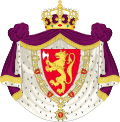Search results
Appearance
There is a page named "Languages of Norway" on Wikipedia
- Many languages are spoken, written and signed in Norway. In Norway, the indigenous languages, Norwegian and Sámi, have official status. Out of them, Norwegian...14 KB (1,456 words) - 23:50, 15 March 2025
- as some extinct languages, constitute the North Germanic languages. Faroese and Icelandic are not mutually intelligible with Norwegian in their spoken...84 KB (6,875 words) - 22:34, 12 March 2025
- other symbols. The Sámi languages (/ˈsɑːmi/ SAH-mee), also rendered in English as Sami and Saami, are a group of Uralic languages spoken by the Indigenous...31 KB (2,933 words) - 02:17, 1 April 2025
- Norway, officially the Kingdom of Norway, is a Nordic country located on the Scandinavian Peninsula in Northern Europe. The remote Arctic island of Jan...227 KB (20,977 words) - 18:10, 4 April 2025
- Norwegian (bokmål) language)the Norwegian language, alongside Nynorsk. Bokmål is by far the most used written form of Norwegian today, as it is adopted by 85% to 90% of the population...25 KB (2,043 words) - 01:49, 8 March 2025dialects, standard language), spelling reform, and orthography. In the United Kingdoms of Denmark and Norway, the official languages were Danish and German...44 KB (5,670 words) - 07:47, 24 March 2025
- The Language Council of Norway (Norwegian: Språkrådet, Urban East Norwegian: [ˈsprôːkroːdə]) is the administrative body of the Norwegian state on language...7 KB (738 words) - 14:11, 29 October 2024
- Germanic languages and the extinct East Germanic languages. The language group is also referred to as the Nordic languages, a direct translation of the most...58 KB (5,550 words) - 20:04, 18 March 2025
- New-Norwegian language)standards of what is today called the Norwegian language. Both written languages are in reality fusions between the Norwegian and Danish languages as they...67 KB (6,452 words) - 19:10, 30 March 2025of the population of Norway, including Jan Mayen, and Svalbard, where the hospital is not equipped for births, and no burials are allowed because of permafrost...78 KB (1,848 words) - 13:26, 23 March 2025
- Generally, speakers of the three largest Scandinavian languages (Danish, Norwegian and Swedish) can read each other's languages without great difficulty...91 KB (9,052 words) - 06:09, 19 March 2025
- The main cities of Denmark–Norway were Copenhagen, Christiania (Oslo), Altona, Bergen and Trondheim, and the primary official languages were Danish and...44 KB (4,301 words) - 19:00, 19 March 2025
- creation of schools for the deaf by Norwegian Lutheran missionaries, the languages are quite distinct. Out of a sample of 96 sign pairs, 18 pairs were identical...3 KB (288 words) - 07:55, 2 November 2024
- languages include some 58 (SIL estimate) languages and dialects that originated in Europe; this language family is part of the Indo-European language...15 KB (1,110 words) - 12:30, 12 November 2024
- Dano-Norwegian (Danish and Norwegian: dansk-norsk) was a koiné/mixed language that evolved among the urban elite in Norwegian cities during the later years...10 KB (1,006 words) - 06:00, 29 October 2024
- two main official languages of Finland are Finnish and Swedish. There are also several official minority languages: three variants of Sami, as well as...25 KB (1,514 words) - 11:22, 12 March 2025
- official minority languages. Kven, which like Meänkieli is mutually intelligible with Finnish, is spoken in the Norwegian counties of Troms and Finnmark...95 KB (9,204 words) - 09:16, 29 March 2025
- The national flag of Norway (Bokmål: Norges flagg; Nynorsk: Noregs flagg; lit. 'Norway's flag') is red with a navy blue Scandinavian cross bordered in...38 KB (3,658 words) - 18:36, 23 February 2025
- do not have any styles in Norwegian, although the style of Highnesses may be used informally in foreign languages. In Norway there is traditionally no...21 KB (2,136 words) - 18:48, 7 March 2025
- or kveenin kieli; Norwegian: kvensk) is a Finnic language or a group of Finnish dialects spoken in the northernmost parts of Norway by the Kven people...19 KB (1,603 words) - 18:18, 18 March 2025
- International Encyclopædia Norwegian Language 1450844The New International Encyclopædia — Norwegian Language NORWEGIAN LANGUAGE. The language which, together with
- Norwegians are a North Germanic ethnic group native to Norway. They share a common culture and speak the Norwegian language. Norwegian people and their
- Know that Norway is the best place to study be able to identify that the Norwegian educational system is unique understand the advantages of Higher Education












